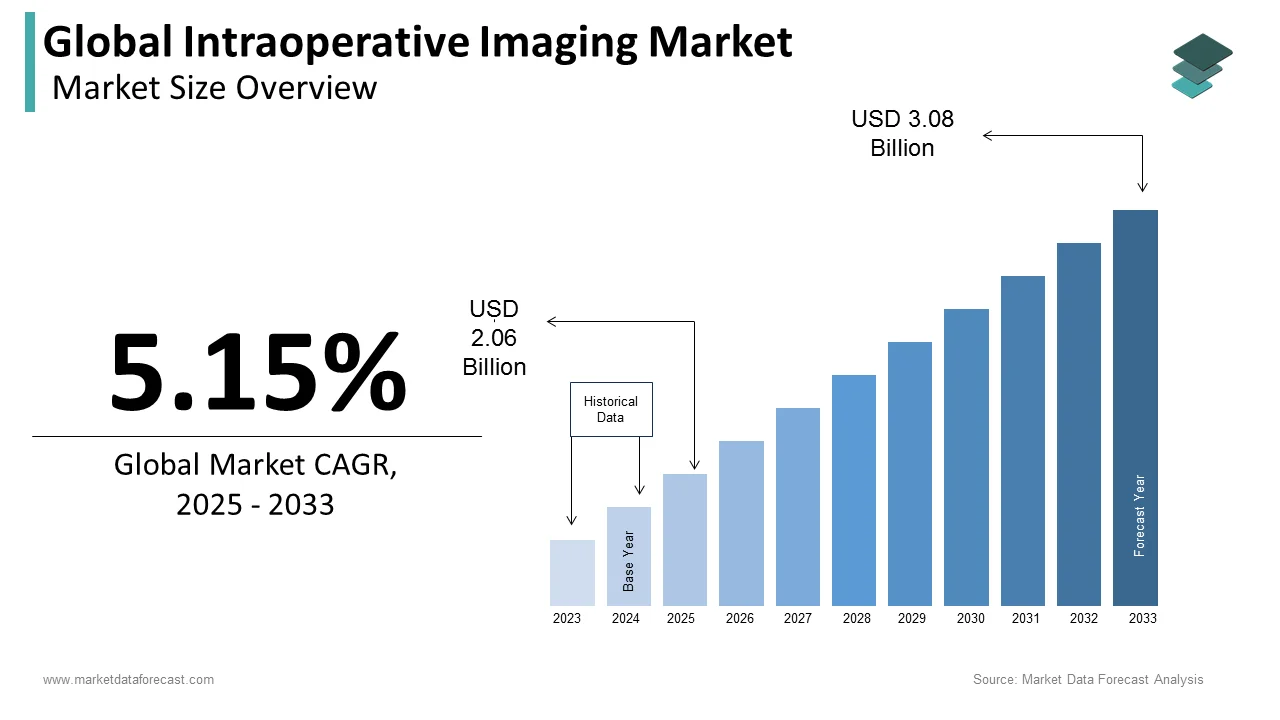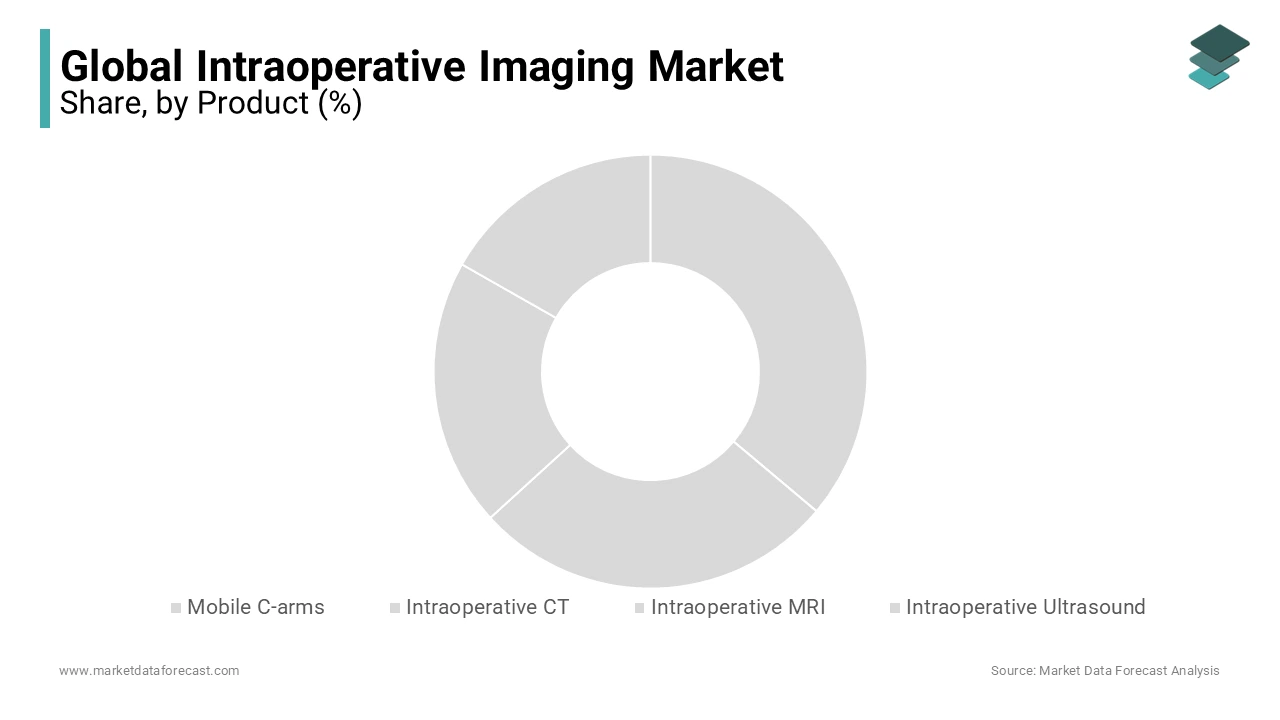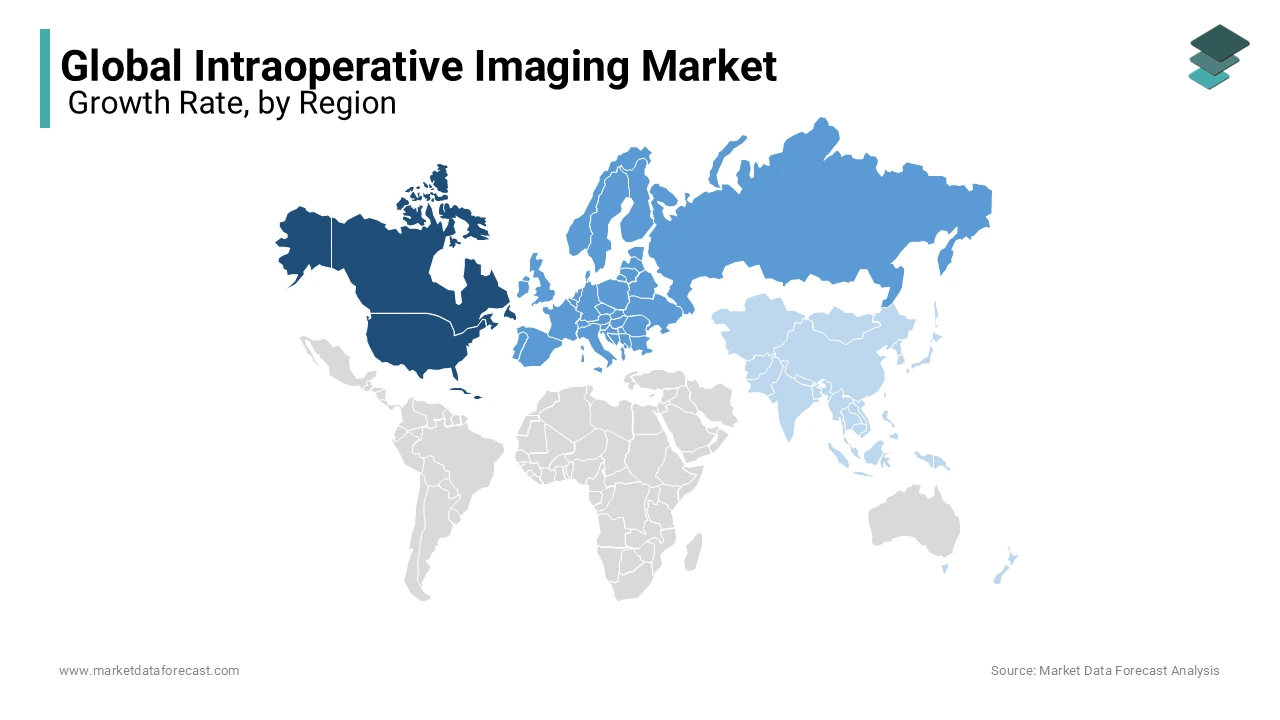Global Intraoperative Imaging Market Size, Share, Trends & Growth Forecast Report By Product (Mobile C-arms, Intraoperative CT, Intraoperative MRI and Intraoperative Ultrasound), Application, End User & Region (North America, Europe, Asia-Pacific, Latin America, Middle East and Africa), Industry Analysis (2025 to 2033)
Global Intraoperative Imaging Market Size
The global intraoperative imaging market size was valued at USD 1.96 billion in 2024. The global market is further estimated to grow from USD 2.06 billion in 2025 to USD 3.08 billion by 2033, progressing at a CAGR of 5.15% from 2025 to 2033.

Intraoperative imaging is at the forefront of a technological revolution in medical sciences. Image-guided operations often use intraoperative imaging equipment. Because the operation target frequently shifts from a previously known location during surgery, pre-operative imaging is less useful for the surgeon. With intraoperative imaging, surgeons may now operate with greater precision. It makes real-time images of the surgery available, which aid in pinpointing the target's precise location. In addition, it aids in the accurate monitoring and management of surgical procedures. The ionizing radiation exposure with long-term effects has been studied by the survivors of the Hiroshima atomic bomb, which resulted in a 60% increase in the development of solid malignancy with one uv of exposure. This led to the discovery of intraoperative exposure, mainly due to scattered radiation. Using images to review surgical steps made due to imaging machines facilitates clinical decisions, increases safety, provides critical post-implantation assessment, and reduces reoperation rates when surgeons see the bone anatomy and soft tissues of the spine before closing the patient.
An intraoperative imaging system is a novel optical imaging technology that assists surgical procedures. Intraoperative imaging technologies use photographs to control the surgical process, which speeds up the procedure. Intraoperative imaging technologies integrate functional cameras and display systems to provide in-depth placement of surgical objectives. Intraoperative imaging is required for surgery on complex organs such as the brain and sinuses, necessitating CT scanners and MRI equipment with 3D sensors.
MARKET DRIVERS
YOY Growth in the Prevalence of Chronic Diseases and Aging Population
Increasing demand for minimally invasive surgeries and a growing number of applications in orthopedic and neurosurgery are further expected to boost the growth rate of the global intraoperative imaging market. Furthermore, rapid developments in the healthcare industry in developed and developing countries and the growing adoption of sedentary lifestyles among people are expected to increase the demand levels for intraoperative imaging during the forecast period. In addition, the increasing focus of governments and private organizations on R&D to develop novel and advanced intraoperative imaging devices adds fuel to the growth rate of the global intraoperative imaging market.
Emergence of Novel and Innovative Intraoperative Imaging Devices and Techniques
There have been many advances lately in neurosurgery, like the development of microsurgical, endovascular, and endoscopic techniques, helping the neurosurgeon achieve precise removal of pathological tissue with minimal disruption of surrounding healthy neural matter, resulting in the performance of most spine surgeries using minimally invasive techniques. In addition, intraoperative imaging not only maintains muscle and tissue health but also verifies surgical accuracy for the efficiency of surgery, helping ensure the desired outcome with the dissection of a tumor or spinal implant at the desired location. There have been many advances lately in neurosurgery, like the development of microsurgical, endovascular, and endoscopic techniques, helping the neurosurgeon achieve precise removal of pathological tissue with minimal disruption of surrounding healthy neural matter, resulting in the performance of most spine surgeries using minimally invasive techniques. In addition, intraoperative imaging not only maintains muscle and tissue health but also verifies surgical accuracy for the efficiency of surgery, helping ensure the desired outcome with the dissection of a tumor or spinal implant at the desired location.
High Adoption of Mobile Room-Based Computed Tomography (CT) Scanners
It has dramatically improved accuracy over traditional fluoroscopy-guided techniques combined with advances in computerized imaging and navigation due to its added advantage of reducing the rate of screw repositioning, improving patient safety, and reducing radiation exposure. In addition, it provides excellent navigation to guide an operation and excellent image resolution, allowing immediate intraoperative intervention before surgical closure, and helping the surgeon obtain immediate CT images at the end of the surgery. Intraoperative fluoroscopy can provide reliable images with information on the level of radiation exposure to the patient, even though it is a traditional method of verifying spine surgeries, which leads to market growth.
Furthermore, the increasing economies of Asia, Europe, North America, and the Middle East offer lucrative growth possibilities for the key players operating in the intraoperative imaging market. In addition, increasing demand for minimally invasive treatment and therapeutic procedures and increased adoption rate of neurostimulation devices provide several growth opportunities for the stakeholders functioning in the intraoperative imaging market worldwide. Some systems orient the patient with the surgical navigation system in various ways. However, these optical surface adaption techniques have limitations, including the skin's movement, the operative site's size, and their suitability for minimally invasive percutaneous procedures. Furthermore, an increasing account of neurological disorders is another major factor that offers growth opportunities for the key players operating in the intraoperative imaging market. In addition, increasing income levels and the evolution of the healthcare sector due to technological advancements in developing countries like India, Brazil, China, and Mexico are creating numerous opportunities for the key players in these regions, leading to expanding the global intraoperative imaging market.
MARKET RESTRAINTS
The expensive nature of intraoperative imaging devices is a significant restraint limiting the global intraoperative imaging market. In addition, high capital investments are required to research and develop novel and advanced technologies and products expected to impede the market's growth. Furthermore, the lack of trained professionals is another major challenge in the global intraoperative imaging market.
REPORT COVERAGE
|
REPORT METRIC |
DETAILS |
|
Market Size Available |
2024 to 2033 |
|
Base Year |
2024 |
|
Forecast Period |
2025 to 2033 |
|
Segments Analysed |
By Product, Application, End-User, and Region |
|
Various Analyses Covered |
Global, Regional & Country Level Analysis, Segment-Level Analysis; DROC, PESTLE Analysis, Porter's Five Forces Analysis, Competitive Landscape, Analyst Overview of Investment Opportunities |
|
Regions Analysed |
North America, Europe, Asia Pacific, Latin America, the Middle East, and Africa |
|
Companies Analysed |
GE Company (U.S.), Siemens AG (Germany), Koninklijke Philips N.V. (Netherlands), Ziehm Imaging GmbH (Germany), Toshiba Corporation (Japan), Medtronic (Ireland), Brainlab AG (Germany), IMRIS Deerfield Imaging (U.S.), NeuroLogica Corporation (U.S.), and Shimadzu Corporation (Japan). |
SEGMENTAL ANALYSIS
By Product Insights
The mobile C-arms segment contributes a significant share of revenues to the global market based on product. These Movable 3D C-arms help enable precise and minimally invasive placement of pedicle screws, are used flexibly in different operating rooms of a clinic, can help the X-ray source and the X-ray detector connect each other, and provide 3D image sets for intraoperative 3D imaging and navigation. It is supposed to continue the trend during the projection period due to the increasing account of cardiovascular diseases and the growing percentage of the senior population, leading to a rise in several orthopedic surgeries.

Intraoperative ultrasound (IOS) is anticipated to dominate the market due to its wide usage as a diagnostic technique during treatment and surgery of the liver since it provides high spatial resolution due to direct contact imaging with the target organ without any interference from surrounding structures. Furthermore, it is an interactive dynamic imaging modality that provides information during surgical procedures timely.
By Application Insights
Based on application, the neurosurgery segment contributes the largest share of revenues to the intraoperative imaging market. Intraoperative neurophysiological monitoring (IONM) involves intraoperatively monitoring neural pathways during orthopedic, high-risk neurosurgical, peripheral nerve, and vascular surgeries through imaging machines, like Intraoperative magnetic resonance imaging (IMRI), on which neurosurgeons rely since it guides them for removal of brain tumors and other treatments also, such as epilepsy, by obtaining precise images of the brain. Furthermore, it is presumed to witness growth at a high pace during the forecast period owing to the increasing demand for minimally invasive techniques among people, the rising prevalence of neurological disorders worldwide, and the growing adoption of neurostimulation devices.
In addition, orthopedics is another crucial market segment concerning the applications and is assumed to display growth over the forecast period. Even in circumstances where full clinical access to the surgical view is present, such as in conventional total hip arthroplasty, orthopedic surgeons can treat patients with musculoskeletal conditions much more effectively thanks to advancements in 3D imaging technology. Intraoperative images are obtained to confirm the correct alignment and orientation of the implant, particularly the acetabular cup, and to rule out concurrent acetabulum fractures.
By End User Insights
The hospital segment is expected to dominate the market due to the wide variety of procedures regularly carried out in hospitals, most of which are done thus. The adoption of robotic surgery and the rise in minimally invasive operations and electrosurgical procedures in hospitals are primarily responsible for this market segment's expansion. In addition, due to their increased purchasing power and higher volume of operations, hospitals employ intraoperative imaging equipment more frequently.
REGIONAL ANALYSIS
The North American intraoperative imaging market is predicted to lead the global intraoperative imaging market during the forecast period due to the significant presence of industry players, the upgrading and expansion of advanced healthcare systems, adequate insurance coverage schemes, and increased healthcare spending.

In 2024, Europe's intraoperative imaging market had the second-largest share of the intraoperative imaging industry. Rising demand for advanced emerging technology and global players in Germany, the United Kingdom, and Switzerland are projected to contribute to the region's overall market development. In addition, growing public and private sector efforts to raise awareness of intraoperative imaging devices are also expected to increase market development. For instance, the European Society of Molecular Imaging (ESMI) has established a research group to draw together all stakeholders in the field of intraoperative imaging, including scientists, surgeons, and manufacturers.
During the forecast period, the intraoperative imaging market in the Asia Pacific is expected to rise faster due to emerging economies, significant unmet needs, and developing healthcare infrastructure in India, Indonesia, and China. In addition, the region's high prevalence of neurological, cardiovascular, and orthopedic diseases is expected to speed up the acceptance of advanced intraoperative solutions.
KEY MARKET PARTICIPANTS
Some of the major companies dominating the global intraoperative imaging market profiled in this report are GE Company (U.S.), Siemens AG (Germany), Koninklijke Philips N.V. (Netherlands), Ziehm Imaging GmbH (Germany), Toshiba Corporation (Japan), Medtronic (Ireland), Brainlab AG (Germany), IMRIS Deerfield Imaging (U.S.), NeuroLogica Corporation (U.S.), Shimadzu Corporation (Japan)
RECENT HAPPENINGS IN THIS MARKET
- In October 2022, the world leader in AI-powered intraoperative imaging, Body Vision Medical, announced the installation of its first system at IEO. This addition would help lung patients with the latest advanced imaging technology and rapid diagnosis of lung nodules by using AI to transform X-ray images into intraoperative 3D images in real-time.
- In October 2022, Body Vision Medical, a global leader in AI-powered intraoperative imaging, released successful results from 45 patients of diagnostic bronchoscopy using a combination of AI-driven authentic images from Body Vision and the Auris Monarch robotics platform, which visualized the location of actual lung injury, for early-stage access to inaccessible lung lesions.
- In November 2022, NuVasive, Inc., the spine technology innovation, launched new minimally invasive surgery systems, NuVasive Tube System (NTS) and Excavation Micro, which help provide reproducible, clinically proven results and comprehensive solutions for TLIF.
- Siemens developed a Cios Alpha mobile C-arm product, which was approved by the U.S food and drug administration in 2016 for its three-model system.
- Philips Healthcare Company collaborated with Bon Secours Charity Health System in 2017. The principal objective of this collaboration is to provide better healthcare in New York through various health programs.
MARKET SEGMENTATION
This research report on the global intraoperative imaging market has been segmented and sub-segmented into the following categories.
By Product
- Mobile C-arms
- Intraoperative CT
- Intraoperative MRI
- Intraoperative Ultrasound
By Application
- Neurosurgery
- Orthopedic and Trauma Surgery
- Spine Surgery
- Cardiovascular Surgery
- Other applications
By End User
- Hospitals
- ASC
- Clinics
By Region
- North America
- Europe
- Asia-Pacific
- Latin America
- Middle East and Africa
Frequently Asked Questions
Which segment by product led the intraoperative imaging market in 2024?
Geographically, the North American region accounted for the leading share of the global market in 2024.
Which region had the highest share in the global intraoperative imaging market in 2024?
The global intraoperative imaging market size was worth USD 1.96 billion in 2024.
Who are the key players in the intraoperative imaging market?
GE Company (U.S.), Siemens AG (Germany), Koninklijke Philips N.V. (Netherlands), Ziehm Imaging GmbH (Germany), Toshiba Corporation (Japan), Medtronic (Ireland), Brainlab AG (Germany), IMRIS Deerfield Imaging (U.S.), NeuroLogica Corporation (U.S.) and Shimadzu Corporation (Japan) are some of the notable players in the intraoperative imaging market.
Access the study in MULTIPLE FORMATS
Purchase options starting from $ 2500
Didn’t find what you’re looking for?
TALK TO OUR ANALYST TEAM
Need something within your budget?
NO WORRIES! WE GOT YOU COVERED!
Call us on: +1 888 702 9696 (U.S Toll Free)
Write to us: sales@marketdataforecast.com
